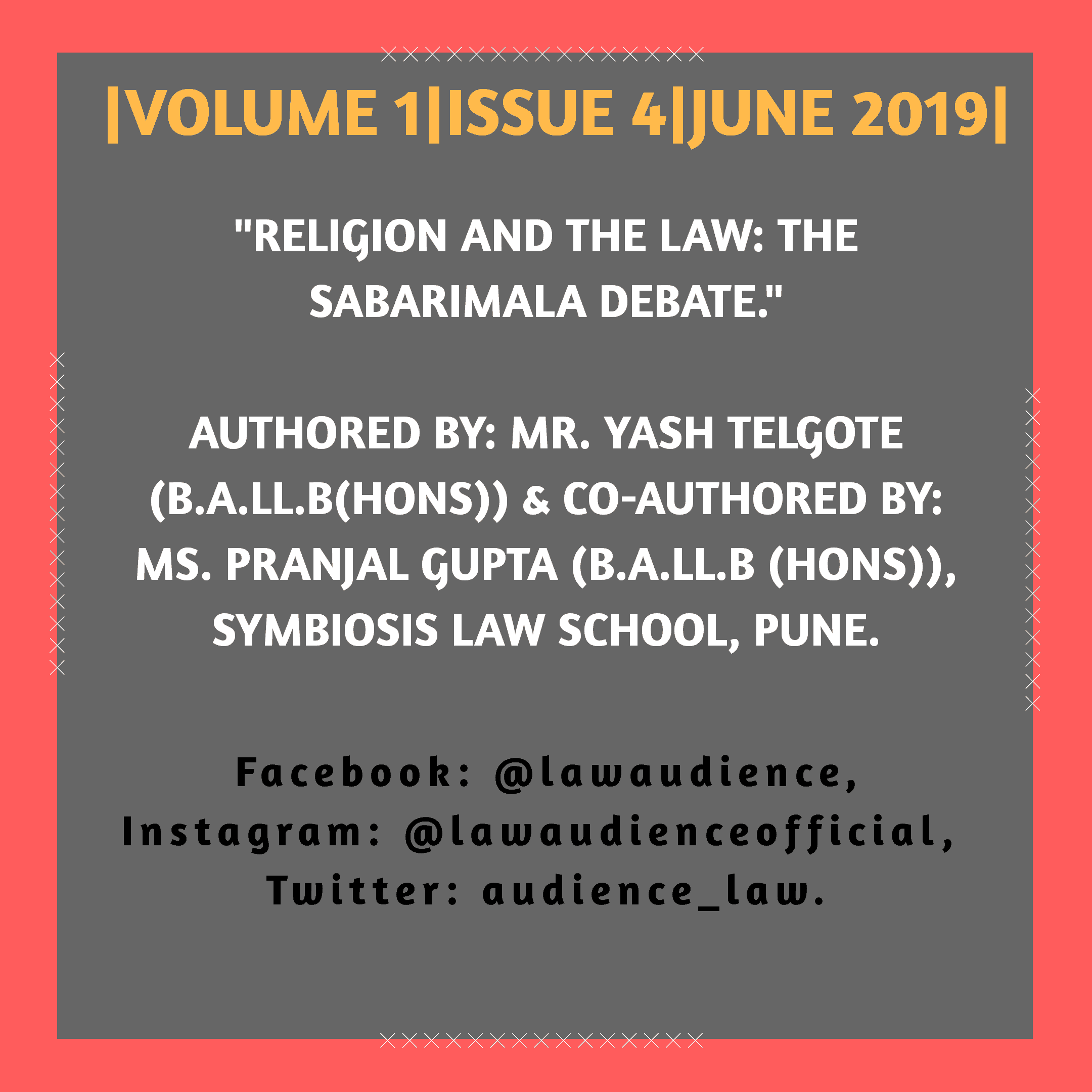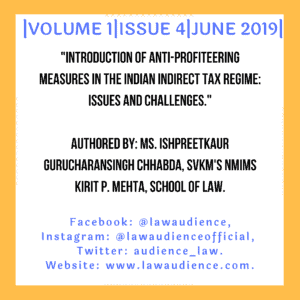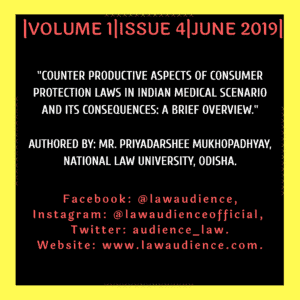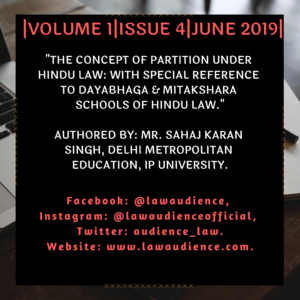Authored By: Mr. Yash Telgote (B.A.LL.B (Hons) & Co-Authored By: Ms. Pranjal Gupta (B.A.LL.B (Hons)), Symbiosis Law School, Pune.
I. INTRODUCTION:
“Law is one of the most important aspects of civilized society, as it maintains the order which is required for the society to function as it is meant to. Though the law may be looked like a set of rules and regulations created by the sovereign for the above purpose, one of the major characteristics of law is growth. Everything changes and so does society and its needs, hence laws are changed over time. Law as present is an absolute command of the sovereign on its subjects.[1] Religion is a particular system of faith and worship. It has been there since time immemorial with humanity. To an individual, religion is something very close to his/her personal life. The Constitution of India recognizes the importance of religion to an individual and hence has provided the Individual with the right to freedom of religion as a Fundamental Right under Article 25 of the Constitution.[2]
But what happens, when Religion comes in the way of Law provided by the sovereign? What is the exact nature of the relationship between Law and Religion?”
II. THE JURISPRUDENTIAL INTERPRETATION TO THE RELATIONSHIP BETWEEN RELIGION AND LAW:
Religion and law may be distinct but they are entwined together and can’t be separated. The essence of law is derived from religion as it is the religion which lays down morals and the lawmakers take those morals into account to frame laws. One may say religion is itself law on account of examples such as Hindu law. Hindu law being one of the oldest laws in the history of law has evolved as a way of life. Through the help of Vedic Shastras and Manu’s scripts, the Hindu law has played an important role in the formulation of modern laws. However, in today’s modern era it is the Hindu Law which derives its power from legislations, judicial decisions and common law.
However, the law may override religion as religious principles will not have any legal authority unless backed up by law. Hence, religion cannot be used as justification to disobey the law. However, it doesn’t mean that lawmakers intend to enter the realm of religion with the force of law. Democracy demands for respect of religion and hence law and religion exist together in harmony. Almost all Indians associate themselves with religion and India being the largest democracy in the world does respect this in its Constitution. The Constitution of India declares the nation to be a secular republic[3] and to uphold the right of citizens to worship and propagate any faith with subject to reasonable restrictions morality, law and order etc. Right to freedom of religion is also considered as Fundamental Right.[4]
In S.R. Bommai v. Union of India,[5] it was held that secularism is the basic tenant of the constitution. Moreover, Article 13 of the Constitution holds customs as laws under the constitution. Hence, all the above authorities point out to one thing that law does acknowledge religion no matter whether such law is based on it or not. Therefore, it can be said that law and religion are an integral part of each other and religion is the very basis of formulation of law from the ancient era to the modern era. Not only Hindu laws support this but also many other personal laws support the same.
III. JUDICIAL APPROACH TO THE RELATIONSHIP BETWEEN LAW & RELIGION: THE SABARIMALA DEBATE:
For the purpose of understanding the relationship between Law and Religion, it is highly important to understand the Supreme Court judgment on Sabarimala i.e. Indian Young Lawyers Association v. State of Kerala[6] as crucial insight was provided by the Supreme Court, which is now the law of our country. In the judgment of the 5-judges bench, there was dissent by Justice Malhotra and a concurrent opinion by Justice Chandrachud, which majorly expands over the nature of the relationship between Law and Religion. Thus, it is important to analyze the opinion given by the Hon’ble judges to come to a conclusion. Hence, the structure of the paper follows analyzing the opinions of the judges in an orderly manner. Justice Malhotra’s dissent is provided before Justice Chandrachud’s concurring opinion as Justice Malhotra had raised some crucial points which were answered in Justice Chandrachud’s opinion.
The core issue in the Sabarimala Case was that there was the exclusion of a class of women from the Sabarimala Temple and the same was justified on the basis of ancient custom. The said custom was sanctioned by Rule 3(b) framed by the Government under the authority of the 1965 Kerala Hindu Places of Worship (Authorization of Entry Act). As per Section 3 of the Act, places of public worship shall be open to all sections and classes of Hindus, subject to special rules for a religious denomination. Whereas Rule 3(b), however, provided for the exclusion of “women at such time during which they are not by custom and usage allowed to enter a place of public worship.” Hence, the above said legislation were scrutinized by the constitutional provisions such as Article 25(1) (Freedom of worship), Article 26 (Freedom of religious denominations to regulate their own practices), and Article 14 and 15(1) (equality and non- discrimination).
In view of the above, the Court had answered several important issues. The same is given in a brief manner down below:
“By Majority, it was decided that the phrase “all classes” under the Act include “gender”.
By Majority and Justice Malhotra dissenting, Sabarimala worshippers do not constitute a separate religious denomination under Article 26, and are therefore exempted under the Act from the operation of Section 3.
By Majority, is Rule 3(b) of the 1965 Rules is ultra vires the 1965 Act. However, Justice Nariman instead of holding it ultra vires straightway holds it unconstitutional under Article 14 and 15(1). Justice Malhotra dissents over the same.
As per Misra CJI, Justice Khanwilkarand Justice Malhotra, if the Act is invalid, the right to exclude can be claimed under Article 25(1) of the Constitution. As per Justice Chandrachud, No, because it violates constitutional morality and as per Justice Nariman also No, because it violates Article 25(1), which stipulates that all persons are equally entitled to practice religion.
By Majority, exclusion of menstruating women from Sabarimala is not an “essential religious practice” protected by Article 25(1). Their answer was on the basis of the facts of the case. Whereas, Justice Malhotra dissented the same.”
III.I ANALYSIS OF JUDGMENT BY FORMER CJI DIPAK MISRA AND JUSTICE A.M. KHANWILKAR:
The devotees of Sabarimala Temple have failed to establish that they were “Separate Denomination”. The test of “Separate Denomination” is a stringent one and requires a system of distinct beliefs, separate name and common organization.[7] Due to Sabarimala public nature i.e., all sections of Hindus and other castes can go and worship Lord Ayyappa in other temples, where the prohibition on women does not apply, leads the two judges to hold that it does not constitute a “Separate Denomination”.[8] Since the temple is governed by a statutory body i.e., the Devaswom Board, the Fundamental Chapters Rights will be applied. Hence, the women have the right to enter the temple under Article 25(1). The above-said right cannot be undermined by the exclusion because, on facts, exclusion of women does not constitute an “essential religious practice” which is protected by Article 25(1).
The reason being that no textual or scriptural evidence backs up the practice and moreover it cannot be said that the invalidation of such practice will change the face and structure of Hinduism. This practice had only been evolved since 1950 and hence lacks the ageless and consistent character required it to become an “Essential religious practice”. Ultimately, it was held that Rule 3(b) is ultra vires the Act as the temple is governed by Section 3 of the Act which states all classes of Hindus shall be allowed, in which the term “class” includes gender as well.
III.II ANALYSIS OF JUDGMENT BY JUSTICE R.F. NARIMAN:
It was accepted by Justice Nariman that the barring of women constitutes an essential religious practice and therefore protected by Article 25(1). However, the devotees still have failed the rigorous test of the separate denomination.[9] Therefore, neither Article 26 nor proviso to Section 3 of the Act is attracted. Therefore, even if there is an essential religious practice barring women, it is still struck by Section 3 of the Act which provides for non-discriminatory access to all classes of Hindus. The Act is a social reform legislation and therefore under Article 25(2)(b) overrides the right to religious freedom.
However, there is a clash between the right of women to enter a temple and the right of priests to exclude a woman under Article 25(1). This clash is decided by Article 25 itself as it says; all persons shall be “equally entitled“. Therefore a right of women to enter a temple is above the right of priests to exclude the women. The argument that not all women are excluded can be of no avail as women between ages 10 to 50 were completely excluded. Also, the argument that the women can worship at any other Ayyappa temple does not stand either as it violates the right to worship in a temple of their choice.
III.III ANALYSIS OF JUDGMENT BY JUSTICE INDU MALHOTRA: A DISSENT:
a) MAINTAINABILITY:
In the era of PILs, the issue of maintainability was taken seriously in this PIL. The right to move to the Supreme Court under Article 32 only arises when there is a violation of the petitioner’s fundamental rights.[10] Whereas, there was no violation of the fundamental rights of the petitioner as they were not the devotees. Justice Malhotra warns us that the issue of maintainability is not a technical question but something more important. It would open the floodgates for all kinds of interlopers to question every kind of religious belief and practices which would cause even a greater peril. The claim is that Article 14 is being violated but in cases of religion and religious beliefs, Article 14 has to be interpreted differently. It has to be adjudged amongst the worshippers of a particular religion or shrine, who are aggrieved by certain practices which are found to be oppressive or pernicious. Such determination can be only made in the presence of persons who are aggrieved. Religions are self-contained and self-referential systems of belief and practice, the question of what constitutes “oppression” will, in most cases, be an internal question.
b) GROUP AUTONOMY:
Within the Constitution, the religious freedom clauses act to insulate religious groups from having their beliefs and practices subjected to judicial scrutiny. Judicial scrutiny under Article 14 would compel the courts to delineate the rationality of religious beliefs and practice, which would be outside the ken of the courts. As per Justice Malhotra, Only practices which are clearly pernicious, oppressive and social evil should be struck down. Justice Malhotra may have made a sensible statement but it lacks conclusiveness and therefore impairs the ability to determine what is pernicious, oppressive or what would amount to social evil.
In simple words, what Justice Malhotra tried to convey is that imposition of rationality by the courts on such religious belief and practice would violate the right to freedom of religion which is guaranteed by the constitution. Religious practices such as Sati do not amount to religious practice at all as it is killing in the name of religion. Whereas, the question of a right to worship is an internal matter within the religion. Therefore, this a pure question of Faith unlike Sati and therefore immune from judicial review and constitutional norms of non-discrimination and equality. Justice Malhotra argues that determination of essential religious practice should be solely left to the religious community itself and therefore strongly rejects the Majority.
This is an important point because it goes entirely against the grain of six decades of Essential Religious Practice jurisprudence, where the Court relying upon textual and scriptural materials makes this determination.[11] It can be said that this is correct as a number of scholars have argued for a while now that the courts are entirely unequipped to make determinations about what practice is or is not “essential” to religion: it lacks both the competence and the legitimacy to do so.
Our Constitution respects religious pluralism. Pluralism entails granting to the diverse religious groups and communities within our nation, the freedom of internal self-government, and the freedom to decide what norms and practices are integral to their existence and functioning. Where these norms or practices result in actual social harm, the Court can step in; however, the Court cannot intervene when the grounds of challenge are limited to bare immorality, irrationality, or unequal treatment. And the Court can especially not do so when the challenge is brought by external parties.
c) RELIGIOUS DENOMINATION:
Justice Malhotra while addressing the issue that whether Rule 3(b) is ultra vires the Section 3 of the Act holds the same in negative on the ground that, the issue of Rule 3(b) being ultra vires does not arises as the worshipper of Lord Ayyappa at Sabarimala constitutes a “religious denomination”, and is therefore exempted from the operation of Section 3 of the Act due to the proviso provided in the Section 3 itself. Unfortunately, this part of Justice Malhotra’s dissent is disappointing. On the basis of a Government Notification and on the basis of a precedent that having distinct beliefs and practices and having a collection of followers who have the same faith would constitute a “Religious Denomination”. Basically, Justice Malhotra by asserting the principle of group autonomy, states that a liberal interpretation should be given to the question of what constitutes a “Religious Denomination”.
Such a statement by Justice Malhotra is disappointing in nature. Essential religious practice is protected under Article 25 and hence it can be justified that a liberal interpretation for the same is needed, whereas a “Religious Denomination” is provided special and differentiated rights under Article 26 of the Constitution. For this reason, the critique of the essential religious practices standards cannot be uncritically applied to the definition of religious denominations: there are good reasons for a higher threshold, adjudicated by Courts.
To depart from that principle would require a detailed and persuasive argument, which Justice Malhotra does not offer. Justice Malhotra had indeed recognized this herself by noting that the proper forum to ascertain whether a sect constitutes a religious denomination or not, would be more appropriately determined by a civil court.
d) MISCELLANEOUS:
Justice Malhotra makes two further findings. Firstly, she rejects the argument that Article 15(2) includes temples under “the place of public resort”. Secondly, she rejects the argument that the exclusion of women in a temple amounts to untouchability under Article 17 as untouchability in only limited to caste-based and not gender based.
III.IV ANALYSIS OF JUDGMENT BY JUSTICE CHANDRACHUD:
Justice Malhotra’s dissenting opinion had left crucial questions such as, how do we reconcile a constitutional commitment to pluralism, which respects for group autonomy with the claims of equality and discrimination within the groups? Justice Chandrachud concurring opinion holds the answer.
As per Justice Chandrachud, discrimination not only comes from state action but also comes from caste and patriarchy which are social institutions. Because they are social institutions, the impact they make on an individual is not merely a private matter. He believes that the significance of this issue had lied in the part where the adjudicatory role of the courts had to be defined on religion in terms of access to a public place. Justice Chandrachud rejects Justice Malhotra’s dissent because of the reason that the issue is about access to a public place.
a) ESSENTIAL RELIGIOUS PRACTICE:
Justice Chandrachud finds that respondents had failed to establish that the practice was an essential religious practice and the fact that Lord Ayyappa was a celibate, does not justify the exclusion of women as a practice. The effect of such practice is to impose the burden of a man’s celibacy on women, which is in no way justified. Such practice is a form of patriarchy, which keeps the women in the position of subordination.
Religion is something which cannot be put in isolation as it is closely linked to an individual’s social life.[12] Hence, judicial scrutiny has to be done on the same.
b) UNTOUCHABILITY:
As per Justice Chandrachud, the exclusion of women is Untouchability under Article 17 of the Constitution. He observes that there was no consensus in the Constituent Assembly over the precise scope and ambit of the phrase. But when going through the broader Constitutional history, the answer is available. Throughout history, there has always been a struggle for social emancipation and unequal social order.
As per the Constitution makers, the Constitution is the end of such struggles[13] and hence, when it’s a denial of basic rights on the basis of a women’s existence itself, giving the justification that their entry would amount to impurity and pollution, that itself constitutes Untouchability.
c) NARASU APPA MALI JUDGMENT:
One of the important things in the concurrent judgment of Justice Chandrachud is that it overrules the Narasa Appa Mali judgment which states that Customs are not subject to Fundamental Rights.[14] Even though in Madhu Kishwar v. State of Bihar,[15] the Supreme Court had already held that the customs are subject to Fundamental rights, but in that case, Naras Appa Mali was not examined.
Customs, usages and personal law have a significant impact on an individual’s civil status and therefore to immunize them from judicial scrutiny are to deny the primacy of the Constitution.
IV. CONCLUSION: WHAT STANDS OF RELIGION IN THE FACE OF LAW?
After going through the opinions given in the judgment, it can be noted that the judgment provided by Misra CJI, Justice Khanwilkar and Justice Nariman was quite straightforward. Misra CJI and Justice Khanwilkar were of the view that such practice cannot stand in the face of Section 3 of the Act which includes entry of all classes. Whereas, Justice Nariman, was of the view that in the right to practice religion, equality constituted a greater part than the practices.
It was, in fact, Justice Malhotra’s dissent and Justice Chandrachud concurrence which defines the actual relationship between Law and Religion at its best. Justice Malhotra was focused on the part that religion has its own significance and hence it should be immunized to a certain aspect from the constitution, whereas Justice Chandrachud was of the opinion that religion holds control over social aspects of the individual as well and hence cannot be immunized from the Constitution.
It is fair to say that Justice Chandrachud states a logically fair argument, but the effect of that was the main concern of Justice Malhotra as this could lead to interference in every matter of a Religion. But it can be clearly said that the Constitution never meant to give way to things which would affect the basic rights of an Individual, even at the cost of some aspects of the religion. Religion, no matter how important was never meant to override the Constitution. For instance, the hierarchy on the basis of caste system was considered an essential part of Hinduism and thus was promoting inequality. Such practice was never intended by the Constitutional makers to be allowed. Therefore, when the religion itself denies the basic rights of an Individual, it affects the rights guaranteed by the Constitution. Hence, it can be fairly said that such aspects of religion which are against the Constitution cannot be sustained. This does not mean that the religion itself is getting wiped out, but instead, the Constitution is allowing the practice of religion in a manner which can sustain the test of Constitutionality. Now, it may be argued that the judges who will provide the test of constitutionality are mere humans and may lead to error or unnecessary interference and it is true that such instances may happen in future, but that does not mean that something unconstitutional can be sustained within a country, a country which has survived over the years on the basis of the Constitution. Can we say that the Constitution is not providing any significance to the religion?
The answer would be no, as freedom of religion is recognized as a fundamental right within the Constitution. The only expectation from the religion is that it should exist in a constitutional manner. Indeed, the Sabarimala Judgment provided crucial insight into the relationship between Law and Religion.
[1] Simran Sabharwal, What is Law?, Ipleaders, October 13, 2018 https://blog.ipleaders.in/what-is-law/.
[2] The Constitution of India, 1950, Art. 25.
[3] The Constitution of India, 1950, Preamble (Justice, social, economic and political).
[4] Supra 2.
[5] S.R. Bommai v. Union of India, AIR 1994 SC 1918.
[6] Indian Young Lawyers Association v. State of Kerala, 2018 SCC Online SC 1960.
[7]Commissioner Hindu Religious Endowments, Madras v. Sri Lakshmindra Thirtha Swamiar of Sri Shirur Mutt, AIR 1954 SC 282; S.P. Mittal v. Union of India and Others, 1983 SCR (1) 729.
[8] Supra note 3.
[9] Supra note 4.
[10] Hans Muller of Nurenburg v. Superintendent, Presidency Jail, Calcutta & Ors, AIR 1955 SC 367.
[11] Adi Saiva Sivachariyargal Nala Sangam v. Government of Tamil Nadu, 2015 SCC OnLine SC 1325.
[12] Supra 3, para 74.
[13] Ibid.
[14] State Of Bombay vs Narasu Appa Mali, AIR 1952 Bom 84.
[15] Madhu Kishwar v. State of Bihar, AIR 1996 SC 1864.



